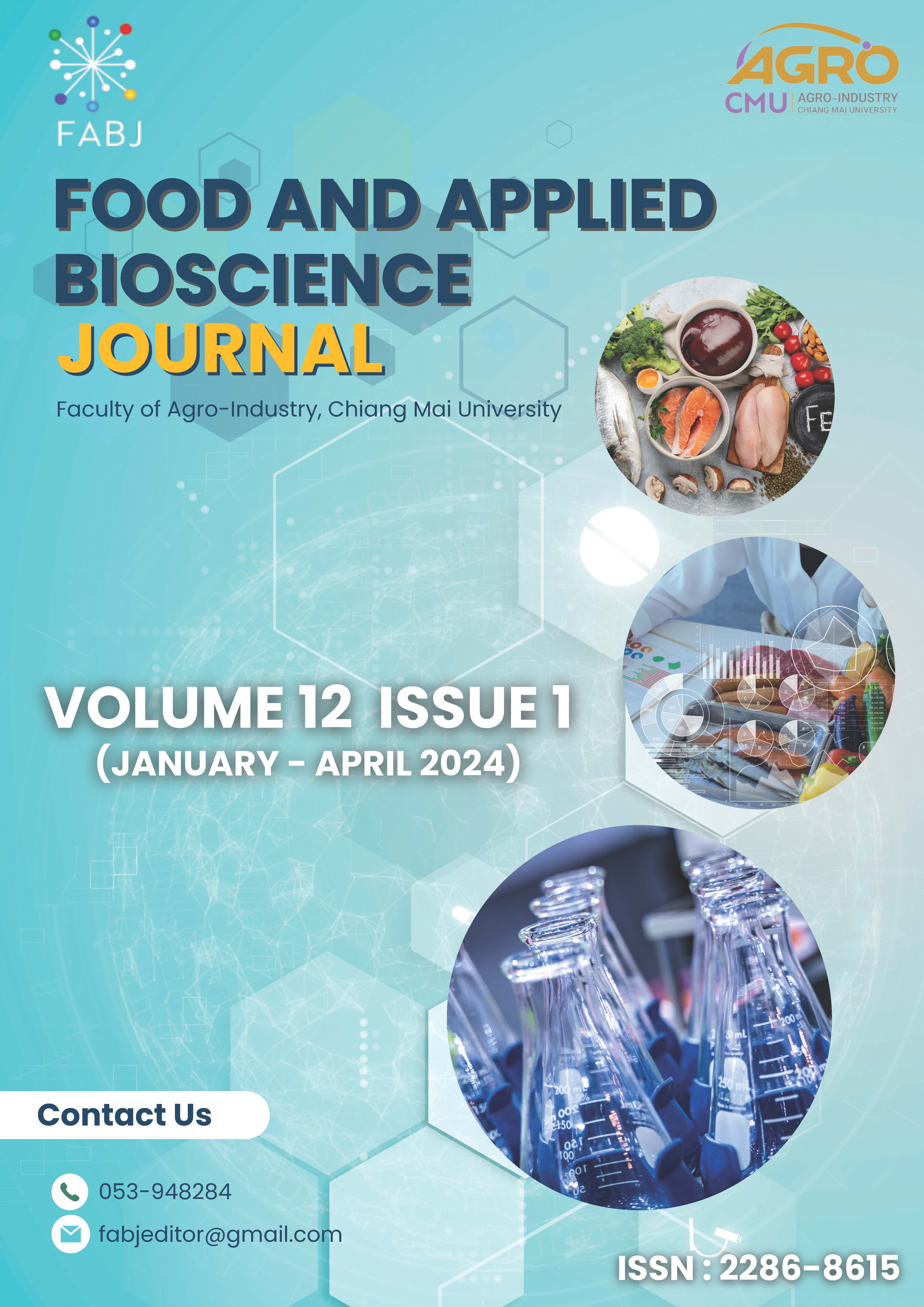Isolation and Screening of Molds from Traditional Look-pang Starter Cultures for Rice Syrup Production
Keywords:
Amylolytic fungi, Starter culture, Rice, SyrupAbstract
Rice syrup can be produced naturally by fermenting cooked rice with microorganisms derived from traditional starter cultures. In this study, we focused on identifying and assessing the sugar production of fungi present in Look-pang, a traditional starter. We employed both submerged fermentation in starch broth and solid-state fermentation techniques on cooked rice to isolate fungal strains from Look-pang. Of these, Aspergillus tamarii stood out for its superior sugar production. The reducing sugar and glucose concentrations achieved from solid-state fermentation using this culture were in line with findings from previous studies. Notably, A. tamarii is known to produce both beneficial health compounds and potential toxins under specific conditions. The significant role of A. tamarii in the fermentation dynamics of Look-pang underscores its potential in advancing organic rice syrup production, representing a step forward in sustainable food processing.
References
Anandan, D., Marmer, W. N. and Dudley, R. L. 2007. Isolation, characterization and optimization of culture parameters for production of an alkaline protease isolated from Aspergillus tamarii. Journal of Industrial Microbiology and Biotechnology. 34(5): 339–347.
Banjo, T., Kareem, S., Akinduti, P., Popoola, T. and Akinloye, O. 2019. Optimization and production of ascorbic acid by fusant cell of Aspergillus flavus and Aspergillus tamarii. Journal of King Saud University - Science. 31(4): 931–936.
Boer, C. G. and Peralta, R. M. 2000. Production of extracellular protease by Aspergillus tamarii. Journal of Basic Microbiology. 40(2): 75–81.
Boro, N. and Narzary, D. 2022. Amylolytic fungi in the ethnic beer starter “emao” and their beer-producing attributes. Frontiers in Sustainable Food Systems. 6: 869430.
Costa, A. M., Ribeiro, W. X., Kato, E., Monteiro, A. R. G. and Peralta, R. M. 2008. Production of tannase by Aspergillus tamarii in submerged cultures. Brazilian Archives of Biology and Technology. 51: 399–404.
Dejsungkranont , M. 2003. Properties of yeasts and moulds involed in Khaomak and Satho fermentation. Kasetsart University, Bangkok.
Ferreira, G., Boer, C. G. and Peralta, R. M. 1999. Production of xylanolytic enzymes by Aspergillus tamarii in solid state fermentation. FEMS Microbiology Letters. 173(2): 335–339.
Goto, T., Ito, Y., Peterson, S. W. and Wicklow, D. T. 1997. Mycotoxin producing ability of Aspergillus tamarii. Mycotoxins. 1997(44): 17–20.
Kadowaki, M. K., Souza, C .G .M., Simão, R. C. G. and Peralta, R. M. 1997. Xylanase production by Aspergillus tamarii. Applied Biochemistry and Biotechnology. 66(2): 97–106.
Kanda, Y. 2013. Investigation of the freely available easy-to-use software ‘EZR’ for medical statistics. Bone Marrow Transplantation. 48(3): 452–458.
Kaweewong, K. 2014. Production of healthy beverage from black glutinous rice. Report of Rajamangala University of Technology Lanna Phitsanulok.
Kim, S. Y., Kim, Y. S., Kim, Y. S., Kim, J. M. and Suh, H. J. 2008. The application of monascal rice in rice beverage preparation. LWT - Food Science and Technology. 41(7): 1204–1209.
Klich, M. A., Mullaney, E. J., Daly, C. B. and Cary, J. W. 2000. Molecular and physiological aspects of aflatoxin and sterigmatocystin biosynthesis by Aspergillus tamarii and A. ochraceoroseus. Applied Microbiology and Biotechnology. 53(5): 605–609.
Limtong, S., Sintara, S., Suwanarit, P. and Lotong, N. 2002. Yeast diversity in Thai traditional fermentation starter (Loog-pang). Agriculture and Natural Resources. 36(2): 149–158.
Ma, Y. M., Liang, X. A., Zhang, H. C. and Liu, R. 2016. Cytotoxic and antibiotic cyclic pentapeptide from an endophytic Aspergillus tamarii of Ficus carica. Journal of Agricultural and Food Chemistry. 64(19): 3789–3793.
Miller, G. L. 1959. Use of dinitrosalicylic acid reagent for determination of reducing sugar. Analytical chemistry. 31(3): 426-428.
Mishra, S., Mithul Aravind, S., Charpe, P., Ajlouni, S., Ranadheera, C. S. and Chakkaravarthi, S. 2022. Traditional rice-based fermented products: Insight into their probiotic diversity and probable health benefits. Food Bioscience. 50: 102082.
Moreira, F. G., Lima, F. A. Pedrinho, S. R. F., Lenartovicz, V., Souza, C.G.M. and Peralta, R.M. 1999. Production of amylases by Aspergillus tamarii. Revista de Microbiologia. 30: 157–162.
Nava, I., Favela-Torres, E. and Saucedo-Castañeda, G. 2011. Effect of mixing on the solid-state fermentation of coffee pulp with Aspergillus tamarii. Food Technology and Biotechnology. 49(3): 391–395.
Oguro, Y., Nakamura, A. and Kurahashi, A. 2019. Effect of temperature on saccharification and oligosaccharide production efficiency in koji amazake. Journal of Bioscience and Bioengineering. 127(5): 570–574.
Premalatha, A., Vijayalakshmi, K., Shanmugavel, M. and Rajakumar, G. S. 2023. Optimization of culture conditions for enhanced production of extracellular α-amylase using solid-state and submerged fermentation from Aspergillus tamarii MTCC5152. Biotechnology and Applied Biochemistry. 70(2): 835–845.
Ramadas, M., Holst, O. and Mattiasson, B. 1996. Production of amyloglucosidase by Aspergillus niger under different cultivation regimens. World Journal of Microbiology and Biotechnology. 12(3): 267–271.
Roongrojmongkhon, N., Rungjindamai, N., Vatanavicharn, T. and Ochaikul, D. 2020. Isolation and identification of fungi with glucoamylase activity from loog-pang-khao-mak (a Thai traditional fermentation starter). Journal of Pure and Applied Microbiology. 14(1): 233–246.
Saigusa, N. and Ohba, R. 2007. Effects of koji production and saccharification time on the antioxidant activity of amazake. Food Science and Technology Research. 13(2): 162–165.
Tamang, J. P., Watanabe, K. and Holzapfel, W. H. 2016. Review: Diversity of microorganisms in global fermented foods and beverages. Frontiers in Microbiology. 7: 377.
Thancharoen, K. and Malasri, A. 2023. Diversity of yeasts and molds isolated from look-pang. RMUTP Research Journal. 17(1): 27–39.
Wongsa, J., Rungsardthong, V. and Yasutomo, T. 2018. Production and analysis of volatile flavor compounds in sweet fermented rice (Khao Mak). MATEC Web of Conferences. 192: 03044.
Yamashita, H. 2021. Koji starter and koji world in Japan. Journal of Fungi. 7(7): 569.
Yang, S., Lee, J., Kwak, J., Kim, K., Seo, M. and Lee, Y. W. 2011. Fungi associated with the traditional starter cultures used for rice wine in Korea. Journal of the Korean Society for Applied Biological Chemistry. 54(6): 933–943.
Downloads
Published
How to Cite
Issue
Section
License
Copyright (c) 2024 Food and Applied Bioscience Journal

This work is licensed under a Creative Commons Attribution-NonCommercial-NoDerivatives 4.0 International License.






